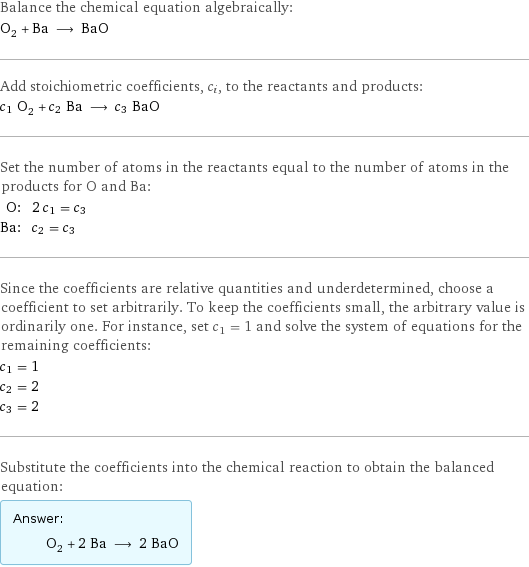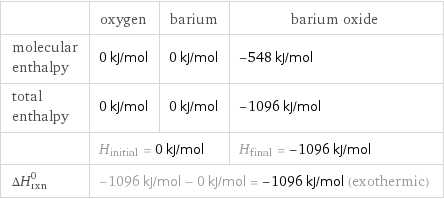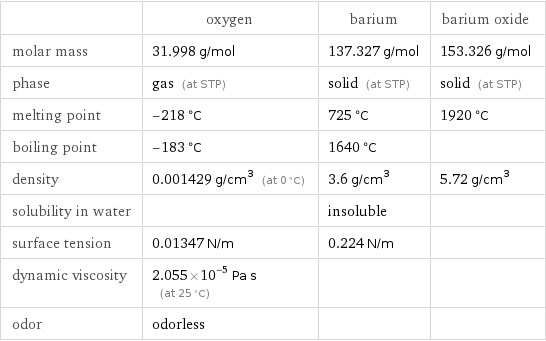Input interpretation

O_2 (oxygen) + Ba (barium) ⟶ BaO (barium oxide)
Balanced equation

Balance the chemical equation algebraically: O_2 + Ba ⟶ BaO Add stoichiometric coefficients, c_i, to the reactants and products: c_1 O_2 + c_2 Ba ⟶ c_3 BaO Set the number of atoms in the reactants equal to the number of atoms in the products for O and Ba: O: | 2 c_1 = c_3 Ba: | c_2 = c_3 Since the coefficients are relative quantities and underdetermined, choose a coefficient to set arbitrarily. To keep the coefficients small, the arbitrary value is ordinarily one. For instance, set c_1 = 1 and solve the system of equations for the remaining coefficients: c_1 = 1 c_2 = 2 c_3 = 2 Substitute the coefficients into the chemical reaction to obtain the balanced equation: Answer: | | O_2 + 2 Ba ⟶ 2 BaO
Structures

+ ⟶
Names

oxygen + barium ⟶ barium oxide
Reaction thermodynamics
Enthalpy

| oxygen | barium | barium oxide molecular enthalpy | 0 kJ/mol | 0 kJ/mol | -548 kJ/mol total enthalpy | 0 kJ/mol | 0 kJ/mol | -1096 kJ/mol | H_initial = 0 kJ/mol | | H_final = -1096 kJ/mol ΔH_rxn^0 | -1096 kJ/mol - 0 kJ/mol = -1096 kJ/mol (exothermic) | |
Entropy

| oxygen | barium | barium oxide molecular entropy | 205 J/(mol K) | 67 J/(mol K) | 70 J/(mol K) total entropy | 205 J/(mol K) | 134 J/(mol K) | 140 J/(mol K) | S_initial = 339 J/(mol K) | | S_final = 140 J/(mol K) ΔS_rxn^0 | 140 J/(mol K) - 339 J/(mol K) = -199 J/(mol K) (exoentropic) | |
Equilibrium constant
![Construct the equilibrium constant, K, expression for: O_2 + Ba ⟶ BaO Plan: • Balance the chemical equation. • Determine the stoichiometric numbers. • Assemble the activity expression for each chemical species. • Use the activity expressions to build the equilibrium constant expression. Write the balanced chemical equation: O_2 + 2 Ba ⟶ 2 BaO Assign stoichiometric numbers, ν_i, using the stoichiometric coefficients, c_i, from the balanced chemical equation in the following manner: ν_i = -c_i for reactants and ν_i = c_i for products: chemical species | c_i | ν_i O_2 | 1 | -1 Ba | 2 | -2 BaO | 2 | 2 Assemble the activity expressions accounting for the state of matter and ν_i: chemical species | c_i | ν_i | activity expression O_2 | 1 | -1 | ([O2])^(-1) Ba | 2 | -2 | ([Ba])^(-2) BaO | 2 | 2 | ([BaO])^2 The equilibrium constant symbol in the concentration basis is: K_c Mulitply the activity expressions to arrive at the K_c expression: Answer: | | K_c = ([O2])^(-1) ([Ba])^(-2) ([BaO])^2 = ([BaO])^2/([O2] ([Ba])^2)](../image_source/763da55eaba83ed7e182ec6825074a02.png)
Construct the equilibrium constant, K, expression for: O_2 + Ba ⟶ BaO Plan: • Balance the chemical equation. • Determine the stoichiometric numbers. • Assemble the activity expression for each chemical species. • Use the activity expressions to build the equilibrium constant expression. Write the balanced chemical equation: O_2 + 2 Ba ⟶ 2 BaO Assign stoichiometric numbers, ν_i, using the stoichiometric coefficients, c_i, from the balanced chemical equation in the following manner: ν_i = -c_i for reactants and ν_i = c_i for products: chemical species | c_i | ν_i O_2 | 1 | -1 Ba | 2 | -2 BaO | 2 | 2 Assemble the activity expressions accounting for the state of matter and ν_i: chemical species | c_i | ν_i | activity expression O_2 | 1 | -1 | ([O2])^(-1) Ba | 2 | -2 | ([Ba])^(-2) BaO | 2 | 2 | ([BaO])^2 The equilibrium constant symbol in the concentration basis is: K_c Mulitply the activity expressions to arrive at the K_c expression: Answer: | | K_c = ([O2])^(-1) ([Ba])^(-2) ([BaO])^2 = ([BaO])^2/([O2] ([Ba])^2)
Rate of reaction
![Construct the rate of reaction expression for: O_2 + Ba ⟶ BaO Plan: • Balance the chemical equation. • Determine the stoichiometric numbers. • Assemble the rate term for each chemical species. • Write the rate of reaction expression. Write the balanced chemical equation: O_2 + 2 Ba ⟶ 2 BaO Assign stoichiometric numbers, ν_i, using the stoichiometric coefficients, c_i, from the balanced chemical equation in the following manner: ν_i = -c_i for reactants and ν_i = c_i for products: chemical species | c_i | ν_i O_2 | 1 | -1 Ba | 2 | -2 BaO | 2 | 2 The rate term for each chemical species, B_i, is 1/ν_i(Δ[B_i])/(Δt) where [B_i] is the amount concentration and t is time: chemical species | c_i | ν_i | rate term O_2 | 1 | -1 | -(Δ[O2])/(Δt) Ba | 2 | -2 | -1/2 (Δ[Ba])/(Δt) BaO | 2 | 2 | 1/2 (Δ[BaO])/(Δt) (for infinitesimal rate of change, replace Δ with d) Set the rate terms equal to each other to arrive at the rate expression: Answer: | | rate = -(Δ[O2])/(Δt) = -1/2 (Δ[Ba])/(Δt) = 1/2 (Δ[BaO])/(Δt) (assuming constant volume and no accumulation of intermediates or side products)](../image_source/5c8a00e661ebc9c229e7ab07cce45279.png)
Construct the rate of reaction expression for: O_2 + Ba ⟶ BaO Plan: • Balance the chemical equation. • Determine the stoichiometric numbers. • Assemble the rate term for each chemical species. • Write the rate of reaction expression. Write the balanced chemical equation: O_2 + 2 Ba ⟶ 2 BaO Assign stoichiometric numbers, ν_i, using the stoichiometric coefficients, c_i, from the balanced chemical equation in the following manner: ν_i = -c_i for reactants and ν_i = c_i for products: chemical species | c_i | ν_i O_2 | 1 | -1 Ba | 2 | -2 BaO | 2 | 2 The rate term for each chemical species, B_i, is 1/ν_i(Δ[B_i])/(Δt) where [B_i] is the amount concentration and t is time: chemical species | c_i | ν_i | rate term O_2 | 1 | -1 | -(Δ[O2])/(Δt) Ba | 2 | -2 | -1/2 (Δ[Ba])/(Δt) BaO | 2 | 2 | 1/2 (Δ[BaO])/(Δt) (for infinitesimal rate of change, replace Δ with d) Set the rate terms equal to each other to arrive at the rate expression: Answer: | | rate = -(Δ[O2])/(Δt) = -1/2 (Δ[Ba])/(Δt) = 1/2 (Δ[BaO])/(Δt) (assuming constant volume and no accumulation of intermediates or side products)
Chemical names and formulas

| oxygen | barium | barium oxide formula | O_2 | Ba | BaO name | oxygen | barium | barium oxide IUPAC name | molecular oxygen | barium | oxobarium
Substance properties

| oxygen | barium | barium oxide molar mass | 31.998 g/mol | 137.327 g/mol | 153.326 g/mol phase | gas (at STP) | solid (at STP) | solid (at STP) melting point | -218 °C | 725 °C | 1920 °C boiling point | -183 °C | 1640 °C | density | 0.001429 g/cm^3 (at 0 °C) | 3.6 g/cm^3 | 5.72 g/cm^3 solubility in water | | insoluble | surface tension | 0.01347 N/m | 0.224 N/m | dynamic viscosity | 2.055×10^-5 Pa s (at 25 °C) | | odor | odorless | |
Units
